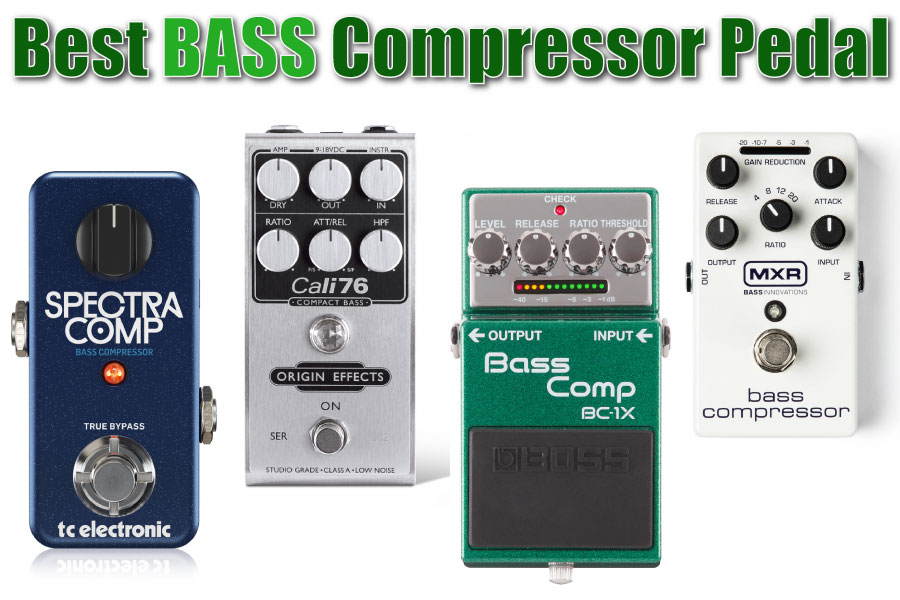What is the best bass compressor pedal available to buy in 2019? We take a look at the top compressor pedals for bass guitar and select which one we’d spend our own money on.
We also explain why you need a compressor, and what the controls on a typical bass compressor pedal do…
Page Index
- Best Bass Compressor Pedal 2019: Our Top Picks
- What does a bass compressor pedal do?
- What do the controls on a compressor pedal do?
- Using a bass compressor pedal
- Do I need a bass compressor pedal?
- Best Bass Compressor Pedals 2019 Round-Up
- Boss BC-1X Bass Compressor Compact Pedal
- Origin Effects CALI76 Compact Bass Compressor Pedal
- MXR M87 Bass Compressor Pedal
- TC Electronic Spectracomp Bass Compressor
- Seymour Duncan Studio Bass Compressor Pedal
- Best Bass Compressor Pedal 2019: Conclusion
- How We Compile Our Round-Up Articles
Best Bass Compressor Pedal 2019: Our Top Picks
Want the lowdown on the best bass guitar compressor of 2019? Below are our top picks…
| Seymour Duncan Studio Bass Compressor Pedal | MXR M87 Bass Compressor Pedal | Boss BC-1X Bass Compressor Pedal |
|---|---|---|
 | 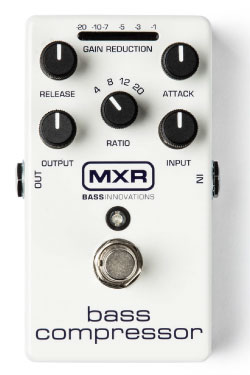 | 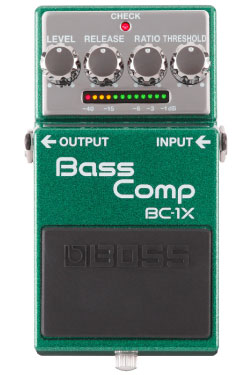 |
 |  |  |
|
|
|
| Click to view price & reviews at Amazon. | Click to view price & reviews at Amazon. | Click to view price & reviews at Amazon. |
What does a bass compressor pedal do?
In a nutshell, a compressor pedal is designed to even out volume levels. By reducing (compressing) the loudest part of the signal, and by boosting the overall level, the compressor produces an output level that is less varied and, on average, louder.
Essentially, a compressor makes the loud bits quieter and the quiet bits louder.
Controls on the compressor pedal allow you to shape the attack and sustain of the sound, as well as to adjust the strength of the compression effect and the overall volume boost.
You know when you’re listening to the radio and the commercials are much louder than the actual show? That’s because the ads are compressed to be as loud as possible.
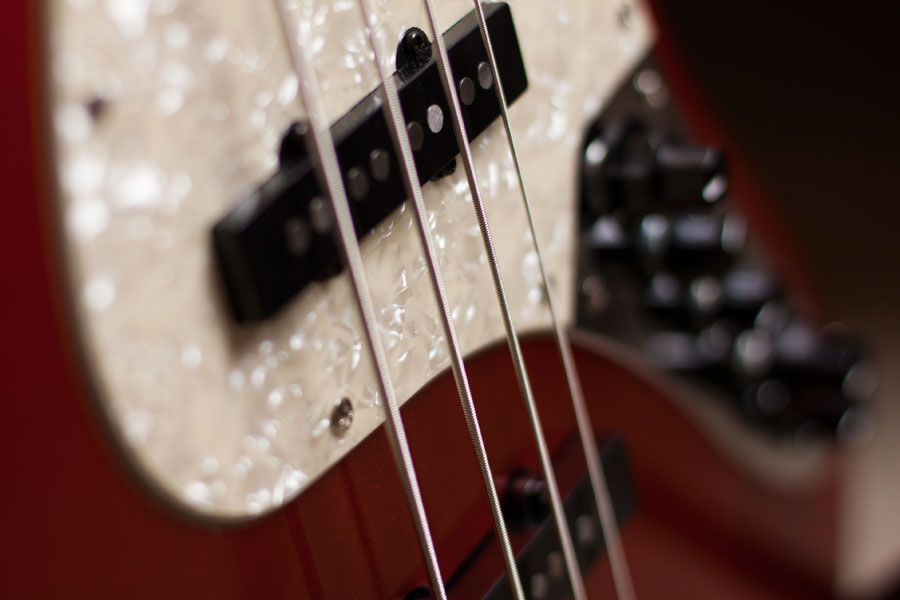
Compression isn’t always a good thing. The ability to play louder and quieter is one way in which we express ourselves as bass guitarists; if we wanted every note to be at the same volume we’d have taken up the Hammond organ!
Like all effects, when used tastefully a compressor pedal will improve your tone. On the flip-side, when used poorly, it can harm your sound.
Much of today’s music is over-compressed. If you look at the waveform of a typical track (and rock musicians are just as guilty as pop producers) then it often looks like a solid block of sound. Although the overall sound is louder, many of the nuances of the music may have been lost.
That said, a compression pedal can be a useful part of a bassist’s pedal board. Used with care, a bass compressor pedal can help create a warm, solid bass sound that will increase your presence in the mix and improve the band’s overall sound.
Play rock or blues? A compressor will fill out your sound, giving you an even volume for laying down the groove. Bring up your sound in the mix, giving your band a professional, ‘radio-like’ sound.
Play fingerstyle? Subtle compression will even out differences between finger strokes, resulting in a warm, consistent tone.
Play aggressive funk or slap bass? Remove the extreme differences in level between your punchy notes and the other notes in your bass lines, giving you more presence and making your sound fill the room (and the dance floor).
What Do The Controls On A Compressor Pedal Do?
Most bass guitar compressor pedals will have the following controls (although they might slightly different names depending on the model).
Threshold Control
The threshold dial controls the level at which the compression effect kicks in. If the input signal is below this level then no compression will be applied.
Ratio Control
The ratio control on a compressor pedal sets the amount of compression (it’s often labelled simply as ‘compression’). If the ratio is set to 2:1, then a 2 dB increase in input level will result in a 1 dB increase in the level outputted by the pedal.
The higher the ratio setting, the more dramatically the sound is compressed; you have to play the strings relatively harder to produce the same output from the pedal.
On the limited physical space available on a foot pedal the actual ratio may not be shown. Just know that by turning the control up you’ll be increasing the ratio, thereby causing a more compressed sound.
Attack Control
The compressor pedal’s attack setting alters the amount of time it takes for the compressor to respond to input above the threshold.
A fast (low) attack setting will result in the compressor quickly reacting to compress input that is over the threshold, quickly pulling down the output level.
A long (high) attack rate can emphasize the picked attack portion of the note.
Release Control
The release control on a compressor pedal sets the length of time it takes for the pedal to stop compressing the sound.
With a fast (low) release, the tail of the sound will be less compressed, resulting in higher sustain. A longer release provides a more gradual return to normal, and a more natural sound.
Level / Gain Control
The level control on a compressor affects the overall output signal level. Without it, you’d be compressing the loudest parts of your playing but doing nothing to the quieter parts, thereby decreasing your overall output level. By dialing up the level control, the level of the quieter (uncompressed) parts is increased. This results in a higher average level.
As you can imagine, dialing up the level knob results not only in a higher signal, but also in more noise. A common problem with compressor pedals is the amount of noise that they produce.
It’s often unnoticeable while playing, but can be a problem between songs or in quiet passages. For this reason, a compressor is often partnered with a noise gate, especially in the studio.
Input Control
Some compressor pedals will also have an input knob allowing you to adjust the pre-compression gain of the signal.
Using a Bass Compressor Pedal
As you can probably tell, using a compressor pedal is a matter of finding a balance between the input signal and your desired output signal. If you change the signal level before it reaches the pedal (i.e. by adjusting the output of your bass guitar, or the output level of your effects loop, for example) then you’ll change the whole balance.
Where the pedal sits in your effects line up is also an important consideration. Experiment putting it before and after other pedals to get the best balance of compression and noise.
Compression can be a very subtle effect. When you get your shiny new pedal don’t be dismayed that the change in your sound isn’t as dramatic as that produced by a chorus or overdrive pedal. It takes time to master the controls on a compressor pedal; eventually, however, you may find that a compressor is one of the most important pedals a bassist can own.
When assessing your compressed sound, adjust the level control so that the output isn’t hugely different to that of the input. This way you’ll be better able to judge the level of compression being applied rather than simply listening to a sound that is the same but louder.
Do I need a bass compressor pedal?
A bass compressor pedal will tame your sound somewhat – that’s what it’s designed to do. If your thing is raw, punchy playing then you may find that compression will remove some of the natural dynamics of your bass.
That said, if the only parts of your playing audible over the other instruments are the clicks and thumps of the strings as they’re being struck – with the longer (and quieter) resonance of the actual notes being lost – then a compressor will bring out more of the nuances of your playing.
That’s got to be a good thing!
Best Bass Compressor Pedals 2019 Round-Up
With all that being said, let’s take a look at our choices for the best bass compressor pedal 2019…
Boss BC-1X Bass Compressor Pedal
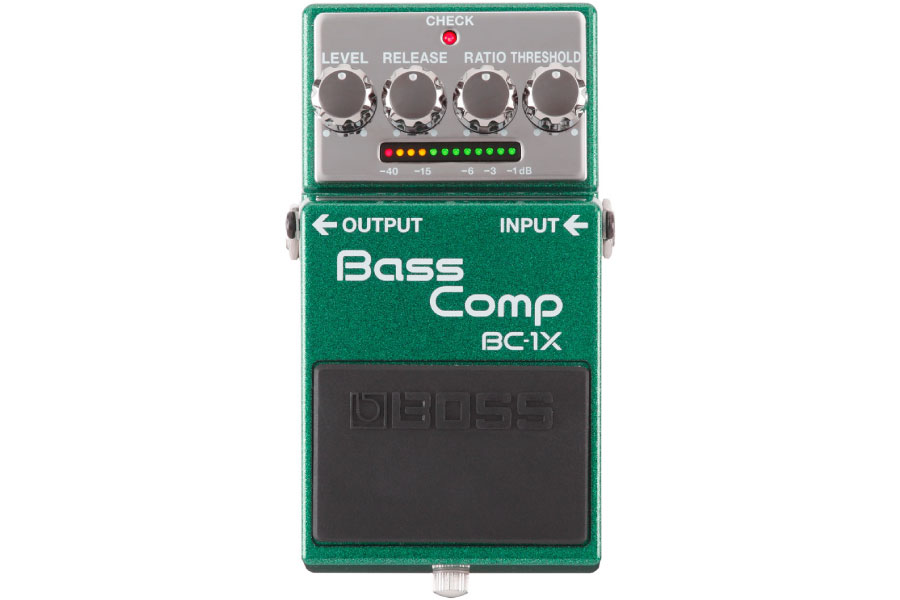
Their words:
Equipped with cutting-edge BOSS technology, the BC-1X Bass Comp performs far beyond the capabilities of conventional bass compressor pedals. This premium stompbox features pro-level multiband compression controlled by intelligent circuitry, making it simple to dial in natural sounds for any playing style.
The advanced design responds to different dynamics and registers to apply the perfect amount of compression in real time, ensuring that your tone never gets over-squeezed or muddy. Transparent, powerful, and easy to use, the BC-1X is a must-have tool that delivers studio-quality punch and precision for dynamic players.
Key features:
- Rugged metal case
- LED display
- Multiband compression
- Powered by battery or via power adapter
What we think:
Boss pedals are known for their rugged construction and reliability. Although not the most expensive pedals on the market, they’re certainly not the cheapest. While they don’t have the desirability of boutique pedals, they do offer a no-frills, professional-quality product, which is why they appear in the effect rigs of countless pro musicians.
The BC-1X Bass Compressor Compact Pedal is one of the few compressor pedals with an LED display. Okay, you’re not going to be looking at this all the time while you’re playing a gig, but a visual representation of how the pedal is shaping your sound is very useful feature.
We’re not totally convinced that multiband compression is absolutely necessary for a pedal designed for just one instrument, but the circuitry may play a part in the unit’s overall sound, so we’ll give Boss the benefit of the doubt.
The BC-1X has received good-to-excellent reviews, and seems to be a professional, reliable bit of kit. Definitely one we’d put on our shopping list.
- See the BC-1X Bass Compressor at the company website
- See BC-1X Bass Compressor reviews and price at Amazon
Origin Effects CALI76 Compact Bass Compressor Pedal
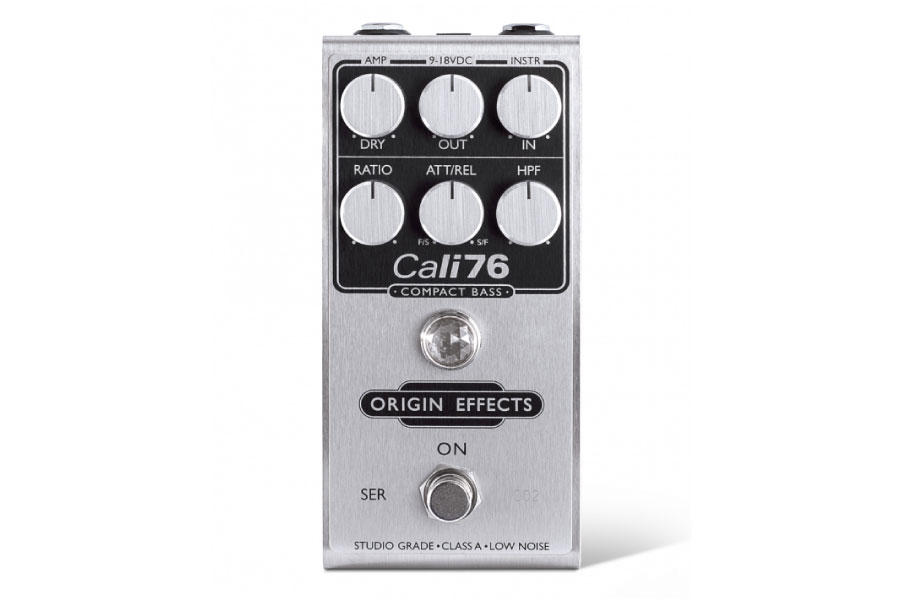
Their words:
The Cali76 Compact Bass is an 1176-style studio-grade FET compressor, complete with dedicated controls for parallel compression and side-chain filtering.
We’ve taken everything that was great about the original Cali76, added new features optimized for bass and compressed the whole lot down into a pedalboard-friendly package!
Key features:
- Ability to balance dry / affected sound
- Classic, ‘industry-standard’ compression effect.
- ‘Boutique’ look.
- Powered by power adapter
What we think:
Urei’s 1176 compressor is one of the classic level-shaping tools. Its solid-state architecture was based around a Field Effect Transistor (FET). The unit became an ‘industry standard’, and it (and its many imitations) has been used on countless classic recordings since its introduction in 1967.
Origin Effect’s CALI76 Compact Bass Compressor Pedal gives you the chance to apply this classic compressor directly to your bass guitar.
We like having the ability to control the ratio of dry and affected signal, although this may be something we’d normally be more concerned about in a studio environment.
We also like the boutique look of the CALI76 Compact Bass Compressor Pedal (hey, we’re only human!). However, this desirability comes at a price; a cheap option this is not.
Nevertheless, reviews are overwhelmingly positive and if you’ve got the readies, why not give it a try?
MXR M87 Bass Compressor Pedal

Their words:
Take your favorite studio compressor to the stage with the MXR Bass Compressor. A complete array of controls-Attack, Release, Ratio, Input, and Output-makes it easy to fine-tune your sound, from subtle peak limiting to hard squashed compression effects.
Its CHT™ Constant Headroom Technology gives you plenty of headroom and clear performance. This totally transparent compressor allows your full dynamic range to shine through until your signal reaches the compression threshold, which is indicated by the ten, highly visible gain-reduction status LEDs. It's all packed into a durable, lightweight aluminum-housing pedal that's the size of a Phase 90.
Key features:
- All the standard compression controls
- LED gain reduction indicator
- True bypass
What we think:
With the inclusion of an input knob the MXR M87 has the full complement of ‘standard’ compression controls and should be accessible both to newcomers and to anyone with experience of using compressors. The unit can be used with a battery or with a power adapter.
We’re not big fans of the compact pedal design (although it may be your thing) and generally would prefer a larger pedal. However, because a compressor isn’t the type of effect you’ll be frequently turning on and off throughout a set, there is a lot to be said for a small, lightweight pedal that can be secured somewhere out of the way.
TC Electronic Spectracomp Bass Compressor
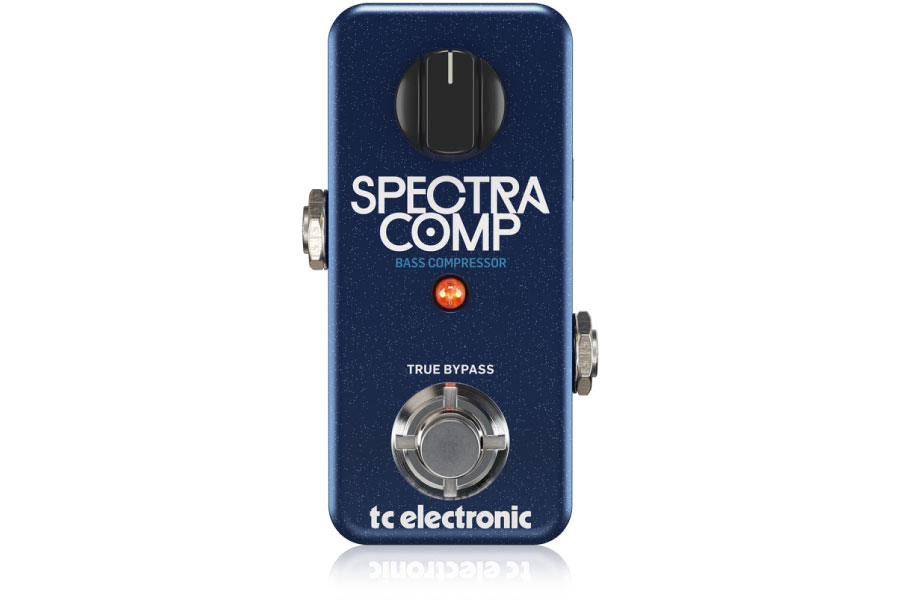
Their words:
SPECTRACOMP BASS COMPRESSOR is the tiniest big thing to hit the world of bass in a long time.
This ultra-compact and highly intuitive multiband compressor is made to bring out all of the glorious low-end punch and presence of your beloved bass in the most transparent and musical way you’ve ever heard. Just turn it on and take charge of the groove.
Key features:
- Compact size
- (Relatively) inexpensive
- Simple controls
- Multiband compressor
What we think:
TC Electronic’s Spectracomp bass compressor is, depending on how you look at it, either the simplest bass compressor pedal in this list, or the most complex.
With only one knob to control the unit’s output, the TC is immediately very easy to use. However, you can increase the unit’s flexibility by using it in combination with TC Electronic’s TonePrint editor app, which is available on both Android and iOS.
‘TonePrints’, which are essentially preset sounds, can be downloaded to your pedal using the app.
The Spectracomp has attracted a raft of favorable reviews. If the idea of an initially simple, but editable-via-app pedal appeals to you, then check it out.
For us, the necessity of downloading an app and using it to interface with the hardware introduces several layers of unnecessary complexity to something that should be an organic, artistic process.
We’ve no doubt that the Spectracomp is a capable bass compressor pedal, but it won’t be on our shopping list.
Seymour Duncan Studio Bass Compressor Pedal
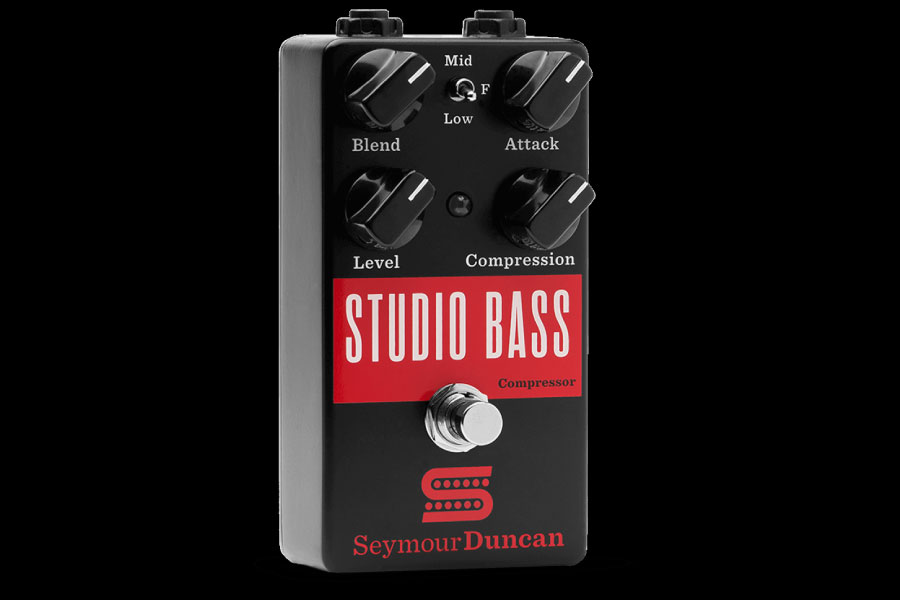
Their words:
This versatile studio-grade compressor is a must have for any bass player looking to maximize their sound, with a range of tones from subtle to super-squashed. One of the secrets to the Studio Bass’s power is its 3-position mini-toggle and blend knob, which give you near limitless control over your tone by letting you mix uncompressed tones alongside the effected sound.
Blend in your unadulterated clean signal, a mid boost that will help you cut through the busiest mixes, or a fat low-end growl. Find that sweet spot where harder picking lifts the dry signal right up above the effected signal or mix in just a hint of the original sound.
Key features:
- Ability to blend in the dry sound of your bass guitar to the final output
- True bypass
- The Studio Bass compressor can be used either with a battery or with a power adapter
What we think:
Although we’re not big fans of the compact style of pedal, we’d be willing to make an exception with Seymour Duncan’s Studio Bass compressor pedal.
This unit gives you the option of mixing the unaffected, dry sound of your bass guitar with the compressed signal, thereby preserving many of the nuances of the original sound.
The small, 3-way toggle switch gives you the added versatility of being able to emphasize either the low or mid frequency of the dry sound (as well as an entirely dry signal).
Various YouTube demonstrations of this pedal in use indicate that the Studio Bass pedal is capable of producing a versatile and impressive range of sounds.
It’s one of the first bass compressor pedals we’d try.
Best Bass Compressor Pedal 2019: Conclusion
Any of the bass compressor pedals featured in this round-up list will do a good job. If we were looking for a new compressor, then we’d probably check out either the Seymour Duncan Studio Bass Compressor Pedal or the MXR M87 Bass Compressor Pedal.
If money were no object, we’d give the CALI76 Compact a try, too.
You can’t really go wrong with a Boss, and if you don’t mind having to download extra sounds from an app, the Spectracomp would be a good, and slightly cheaper, choice.
How We Compile Our Round-Up Articles
We’ve taken a long, hard look at the range of bass compressor pedals currently available to produce this buyer’s guide. We arrived at this best-of list by considering factors such as media reviews, user reviews, YouTube demos and our own personal experience.

